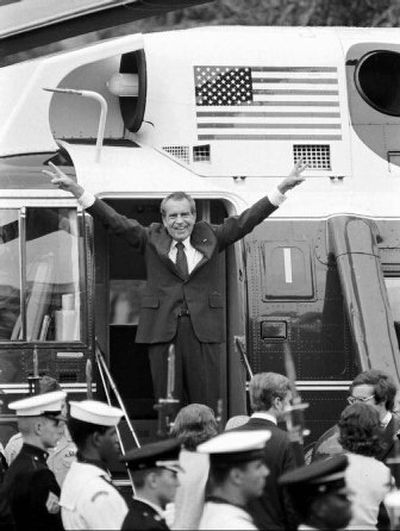Nixon’s loyal pilot restores helicopter

RIVERSIDE, Calif. – Gene Boyer remembers Aug. 9, 1974, as an agonizing day. It was the day the then Army helicopter pilot flew President Richard Nixon off the White House lawn for the last time.
“The last flight was rather difficult for me,” 76-year-old Boyer said recently. “I liked him.”
Thirty-one years later, Boyer and a crew of volunteers are restoring that helicopter in a hangar on the edge of March Air Force Base, east of Los Angeles.
Boyer, who retired as a lieutenant colonel, flew helicopters for Presidents Lyndon Johnson, Nixon and Gerald Ford, taking Nixon on 184 trips, including the final flight on the day he resigned as president.
“I thought that this helicopter, with all its history, was worth finding,” said the tall, lanky Boyer, who managed to track it down in New England, get it transported across the country and line up volunteers to refurbish it. He also helped secure a place for its permanent display starting next year at the Richard Nixon Library & Birthplace in Yorba Linda, Calif.
The quest began five years ago, when Boyer finally traced the aircraft to a Navy museum in Quonset Point, R.I.
With the help of the Air Force, he arranged to have the helicopter transported in October to the hangar at the March Field Air Museum.
The helicopter, which was also used by President John F. Kennedy, needs a lot of work on its exterior, but the cabin is in excellent shape: All of the seats and couches are covered in the original fabric.
The former Army officer reminisced about his time as Nixon’s pilot, during which time he flew Nixon and Egyptian President Anwar Sadat to the pyramids outside Cairo and made the first helicopter landing in St. Peter’s Square, when he brought Nixon to the Vatican for a meeting with Pope Paul VI in 1970.
But the flight that Boyer remembers as the most historic was the final journey from the White House to Andrews Air Force Base, where he brought the just-resigned Nixon for his flight back to California.
“I received a call the night before,” Boyer said.
He was in the cockpit as Nixon and his family left the White House. As Boyer waited, Nixon stood on the steps of what was then designated as Army One and gave his iconic V-for-victory salute with both hands as he grinned widely.
After the short flight to Andrews, Boyer said, Nixon and his wife, Patricia, both came to say goodbye to him in the cockpit.
“He thanked me for all the flights,” Boyer said. “I had tears in my eyes.”
During the following years, Boyer visited Nixon “dozens of times” by his reckoning and decided that restoring the former presidential helicopter was a fitting tribute.
Although the cabin is in good shape, the cockpit is missing a lot of instruments and gauges, parts that have proven hard to find.
There have been delays, but Boyer is confident that work can be completed by early next year. The craft will then be transported to the Nixon library in Yorba Linda for permanent display.